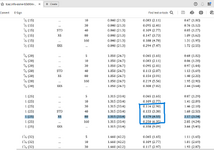Simba12345
Mechanical
- Jul 2, 2023
- 3
Hi,
I am doing the calculations for selecting pipe wall thickness using asme b31.3.
the pipe application will be the transfer of high pressure water from a plunger pump to spray bars with atomizing nozzles. the pump has a PRV that operates at 250 bar and saftey valve is set at 290 bar.
the customer wants to use stainless steel pipes.
I am using formula (3a) "304.1.2 Straight Pipe Under Internal Pressure"
it is a seemless pipe with material grade is TP316L spec no A312. (alowable stress is 16700 psi)
working temperature 20-30 C.
1st question is that what design pressure do i use? 250, 290 or higher?
I have done the calculations using 300bar as the desing pressure and the biggest pipe OD that i could find to work was 1 inch pipe sch80s with OD of 1.315.
Follow up question, how are the bursing pressures in ASTM a312 stainless steel pipes chart calculated? when should that chart be used.
difference between desing pressure and bursting pressure?
sorry i have been looking at all the different information and am a bit confused.
I am doing the calculations for selecting pipe wall thickness using asme b31.3.
the pipe application will be the transfer of high pressure water from a plunger pump to spray bars with atomizing nozzles. the pump has a PRV that operates at 250 bar and saftey valve is set at 290 bar.
the customer wants to use stainless steel pipes.
I am using formula (3a) "304.1.2 Straight Pipe Under Internal Pressure"
it is a seemless pipe with material grade is TP316L spec no A312. (alowable stress is 16700 psi)
working temperature 20-30 C.
1st question is that what design pressure do i use? 250, 290 or higher?
I have done the calculations using 300bar as the desing pressure and the biggest pipe OD that i could find to work was 1 inch pipe sch80s with OD of 1.315.
Follow up question, how are the bursing pressures in ASTM a312 stainless steel pipes chart calculated? when should that chart be used.
difference between desing pressure and bursting pressure?
sorry i have been looking at all the different information and am a bit confused.

